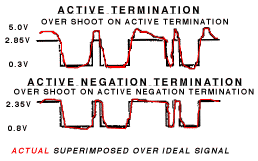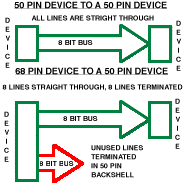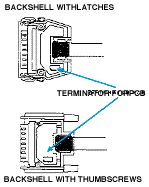Newsletter Volume 1 Issue 4 Conforming to ANSI SCSI 3 Specifications Impedance, Termination and Connection have new looks and requirements
Highlights Inside 
ANSI SCSI Committee Shapes Future of Interface
It begins with a meeting of the ANSI SCSI Committee and it can end with certain confusion and frustration for your SCSI peripheral customers. Solving problems with changing standards can be as simple as plugging a cable onto a SCSI device or as difficult as troubleshooting the SCSI bus.
What Resellers Need to Know
Resellers need to know how to solve their customers' problems before they happen. Selling tomorrow's downward compatible solutions today can be much easier than troubleshooting a SCSI bus or determining the future needs of your customer.
Cable Connection can help. We specialize in providing the latest ANSI SCSI compliant interconnect and termination solutions for today's FAST/Ultra SCSI devices.
There is a direct correlation between data transfer speeds and the need for tighter cable and termination specifications. Older FAST SCSI I controllers and devices were only capable of sustained data transfer rates of up to 10 megabytes per second across an 8-bit bus. FAST SCSI II allowed for sustained data transfer rates of up to 20 megabytes per second across a 16-bit bus.
The most recent FAST SCSI 3, or Ultra SCSI as it is commonly referred to, is now capable of data transfer rates of 40 megabytes per second across a 32-bit bus.
In order to maintain the signal quality at today's higher data transfer speeds, the ANSI SCSI committee has defined more stringent specifications for connecting and terminating Ultra SCSI devices to an Ultra SCSI bus (controller).
Issues like cable impedance, the characteristic associated with signal reflections on the SCSI bus caused by normally occurring logic transitions, are critical to the performance of the bus. If the impedance of the cables on the SCSI bus are matched closely to the bus, errors due to signal reflections can be eliminated. All of Cable Connection's SCSI cable assemblies meet the
impedance requirements defined in the latest ANSI SCSI specifications (90 ohms +/-6 ohms for the ACK and REQ pairs and +/-10 ohms for all remaining pairs). The good news for resellers is that all Cable Connection cable assemblies are built to meet the latest FAST/Ultra SCSI specifications. Our cables are downward compatible so you can feel confident that the connection you are selling will work for SCSI I - 3 and FAST/Ultra SCSI applications.
Smaller Form Factor
The latest SCSI 3 specification comes with a new 68-position SCSI connector. The new .8mm connector (see figure 1) is almost 50% smaller than the original 0.50" series connectors. Many SCSI controller manufacturers have already adopted this new connector into their latest high-end SCSI 3 controller designs.

Figure 1
.8mm SCSI 3 Connector
As the SCSI market continues its move toward smaller, faster devices the use of the new .8mm connector should continue to grow. The complete transformation to the smaller .8mm footprint connector is still questionable as the volume of controllers and
devices today are still shipping with the larger 0.50" connection scheme. Cable Connection manufactures and stocks a full line of SCSI 3 cables in both 0.50" and the new .8mm connector styles. Ordering FAST/Ultra SCSI 3 cables with the new .8mm connector is simple.
The following is a list of our most commonly requested SCSI 3 .8mm and SCSI 3 .8mm transition cables;
Part Number | Description | S-68UM68UM-03 |
3', .8mm - .8mm | S-68UM68UM-06 | 6', .8mm - .8mm |
S-68UM68M-03 | 3', .8mm - Mini 68 | S-68UM68M-06 |
6', .8mm - Mini 68 | S-68UM50M-03 | 3', .8mm - Mini 50 | S-68UM50M-06 | 6', .8mm - Mini 50 | 
Active Negation Termination is Required for SCSI 3 Interface The ANSI SCSI committee has mandated the use of Active Negation termination on the SCSI 3 bus. To ensure consistent signal integrity at higher data transfer speeds afforded by the new SCSI 3 controllers and devices, customers will require Active Negation terminators.
Active Negation terminators are different from typical active terminators in that they restrict the signal voltages to 3 volts. Limiting
the signal voltages helps reduce signal overshoot (see figure 2). Reducing signal overshoot improves signal timing and integrity, essential to maintaining high speed data transfers.

Figure 2
Active vs. Active Negation Termination
Cable Connection stocks Active Negation terminators in both 68- and 50-pin configurations. If you are terminating a SCSI II or SCSI 3 device on a SCSI 3 bus, Cable Connection will have the Active Negation termination solution your customer will need.
SCSI Transition
Attaching a 50-pin SCSI device to a SCSI 3 bus requires more than just a transition cable (68-pin to 50-pin cable). Terminating
the unused data lines requires pass-through Active Negation Termination. Pass-through terminators typically plug in between the last 68-pin SCSI device and the first 50-pin SCSI device terminating the 8 unused data lines (see figure 3). These terminators are expensive and can easily be misplaced when moving peripherals from one work station to another. Cable Connection has found a better way!

Figure 3 Pass-Through Termination
Cable Connection has designed and currently manufactures self-terminating cable assemblies. Built in Active Negation Termination eliminates the need for a pass-through terminator, cutting connection costs and resellers' worries.
By including an Active Negation terminator inside the connector backshell (see figure 4), we can do away with the external pass-through termination.

Figure 4
Cable Connection's Built-In Active Negation Termination
Cable Connection carries a wide variety of self-terminated transition cables. These are just a few of the more popular assemblies:
Part Number | Description | S-T68M50C-03 | 3', 50 Cent - Mini 68 | S-T68M50C-06 | 6', 50 Cent - Mini 68
| S-T68M50M-03 | 3', 50 Mini - Mini 68 | S-T68M50C-06 |
6', 50 Mini - Mini 68 |

Questions and Answers
Q: Will a SCSI II controller run a SCSI 3 device?
A: Typically no. Most SCSI 3 devices will not run on a SCSI II controller although there are a few disk drives which can be configured in this mode. Check with the disk manufacturer to be sure your drive has this capability.
Q: Can I use Active Termination on my controller and Differential Termination on my device?
A:
No. Differential Termination can only be used when both the device and the controller are Differential. Additionally, you cannot use Active Termination on a device with Passive Termination on the controller.
Q: Can I use a 10 meter SCSI cable to attach my RAID to my Ultra SCSI controller?
A: No. The maximum distance for an Ultra SCSI bus is very short. In fact the ANSI SCSI committee recommends that the entire
bus length not exceed 3 meters with 4 devices or 1.5 meters with 8 devices. |

